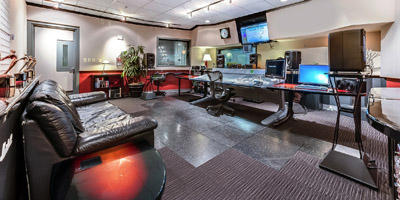Audinate Networking Powers Microsoft Studios

One of the Microsoft Production Studios audio rooms
REDMOND, WASH.—Microsoft Production Studios is a full-service digital media production facility located on the Microsoft campus. Our full-service HD and 4K video production facility is among the largest of its kind in the region, incorporating three sound stages, three audio rooms and numerous editing suites within its 65,000 square feet.
MOVING TO DIGITAL NETWORKING
As with any advanced video operation, audio is an integral part of our workflow. Increasingly, we’ve transitioned to Audinate’s Dante digital media networking system to effectively manage the many audio channels and applications that cross our broadcast and production workflow.
Our transition to Dante began with a sound design and mixing focus, and has rapidly progressed to the point where it crosses all audio production, post-production and intercom applications. The high-quality, low-latency multichannel transport benefit of Dante especially shines for our broadcast television productions, which range from popular cable shows and retail programming delivered to Microsoft stores.
The growth of our Dante network really took off on the intercom side. We have long used RTS ADAM intercom systems, and have leveraged that infrastructure to upgrade to a Dante-enabled architecture. This has allowed us to centralize audio and intercom communications on a common network. The Dante’s low-latency means that all audio transport arrives at its destination without delay, eliminating lapses in intercom communications during production.
SIDE BENEFITS ARE IMPORTANT
The transition to Dante has also minimized cabling and infrastructure requirements, creating a simpler and more cost-efficient audio and communications system. With everything software-routable, all Dante audio signals pass over minimal fiber and network cable. The resulting benefit is a noticeable cost savings that extends beyond the actual infrastructure to labor in initial integration and also in ongoing maintenance.
The bidirectional architecture incorporates two channels of Dante in each intercom panel, maximizing flexibility for remote productions across the greater Microsoft campus. The first channel in each panel supports back-end intercom operations and the second channel is fed via Dante. For remote productions, we often output Dante audio from lavalier and handheld microphones for transport via fiber back to production control where the program audio is mixed on our Dante-enabled Yamaha console, and intercom feeds are routed to other production staff.
The flexibility, scalability and low latency of Dante has also opened up some new opportunities for in-store video. We use the Dante Virtual Soundcard to output audio from computers via an Ethernet network card, delivering that audio to a Symetrix Edge router for distribution to multiple in-store zones. Each of these can playout unique channels from Dante’s high-capacity architecture to allow playback of pre-recorded content. Our Dante network also now includes a Focusrite RedNet 6 MADI bridge to a Miranda (Grass) audio/video routing system, creating new opportunities for delivering live IP streams worldwide.
The possibilities of the Dante network are almost limitless, and our goal is to connect as many audio sources and feeds to the Dante network as possible, across MADI, ProTools, intercom systems and more. Overall, Dante is certainly accelerating our transition to IP across multiple broadcast and production applications.
John L. Ball is a systems engineer at Microsoft Production Studios. He may be contacted at johnl.ball@microsoft.com.
For additional information, contact Audinate at 503-224-2998 or visit www.audinate.com.
Get the TV Tech Newsletter
The professional video industry's #1 source for news, trends and product and tech information. Sign up below.
